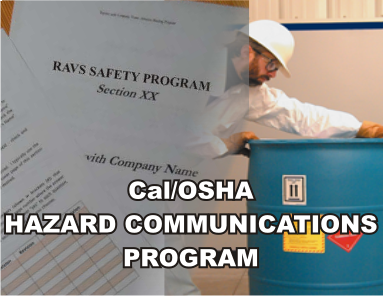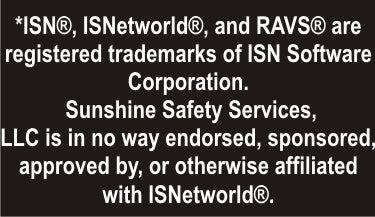Cal/OSHA Hazard Communications Program - ISNetworld RAVS Section - US
$ 34.95
Cal/OSHA Hazard Communication Program (GHS) - ISNetworld RAVS Section - US

This Cal/OSHA Hazard Communication Program (ISNetworld® RAVS®* Section), in addition to being a complete and functioning written safety program (chapter), it also contains all the required text elements that are sought by the ISNetworld RAVS® (Review And Verification Service) reviewer. This plan has been previously submitted and has achieved a 100% approval rating for our clients.
- All programs are guaranteed now and in the future to achieve 100% approval.
- There are NO maintenance or subscription fees.
- Simply notify us if any program falls out of compliance and we will correct it at NO CHARGE.
You are downloading a MicroSoft® Word document file to your computer that is completely editable:
- Cal/OSHA Hazard Communication Program (GHS):
- Approximate Word Count: 11,900
- Approximate Number of Pages: 45
- Page Reference Answers to RAVS Reviewer’s Questions: 5
You will also receive instructions for a simple two-step process to place your company name and safety person's name throughout this word document to conform it to your company. Please review, and feel free to alter or add to it as you wish with any specific company information or safety policies that you may already have.
The first two pages of the document are guidelines for conforming this safety manual section, an index for completing the RAVS® questionnaire (with all page references), and uploading the section.
If you experience any difficulty filling out the questionnaire, or have any questions in general about these documents, call 314-698-7915, or e-mail me at vsunshine1@gmail.com.
An excerpt from ISNetworld® RAVS®* Safety plan Cal/OSHA Hazard Communication Program (GHS) Program
Introduction
About 32 million workers are potentially exposed to one or more chemical hazards. There are an estimated 575,000 existing chemical products, and hundreds of new ones are being introduced annually. This poses a serious problem for exposed workers and their employers. Chemical exposure may cause or contribute to many serious health effects such as heart ailments, kidney and lung damage, sterility, cancer, burns, and rashes. Some chemicals may also be safety hazards and have the potential to cause fires and explosions and other serious accidents.
Because of the seriousness of these safety and health problems, and because many employers and employees know little or nothing about them, the Occupational Safety and Health Administration (OSHA) issued, in 1983, a rule called “Hazard Communication” that applies to employers in the manufacturing sector industry. The scope of the rule was expanded in 1987 to include employers in the non-manufacturing (including construction) sector, and revised again in May 2012 to align it with the Globally Harmonized System of Classification and Labeling of Chemicals (GHS).
The basic goal of the standard is to ensure that employers and employees know and understand about chemical hazards and how to protect themselves. This knowledge, in turn, should help to reduce the incidence of chemical source illnesses and injuries.
The Hazard Communication Standard (HCS) establishes uniform requirements to assure that the hazards of all chemicals imported into, produced or used in U.S. workplaces are evaluated, and that the resultant hazard information and associated protective measures are transmitted to affected employers and potentially exposed employees.





